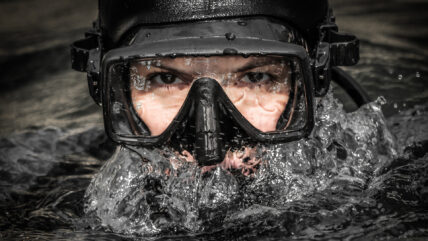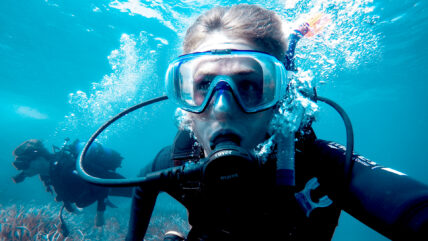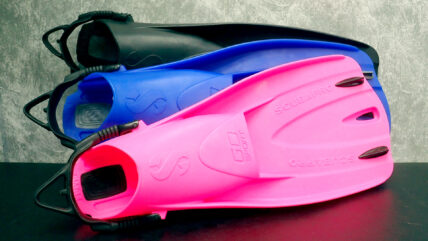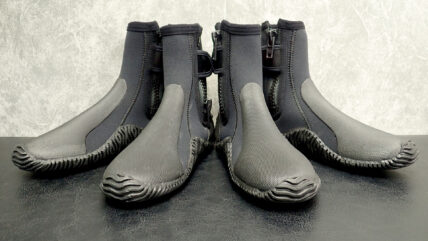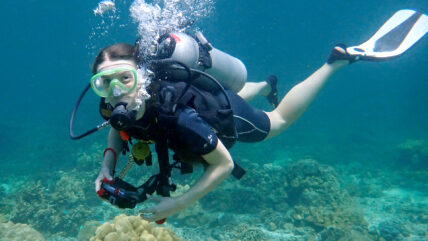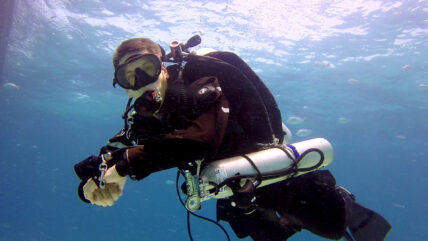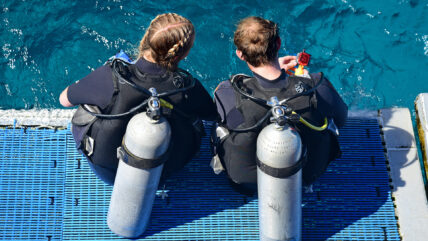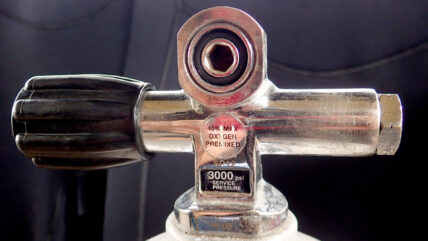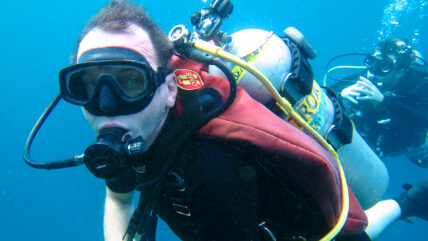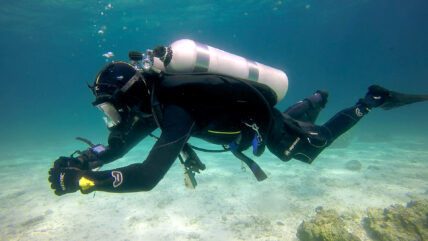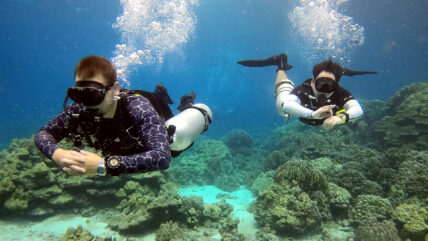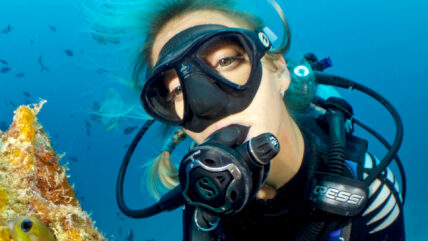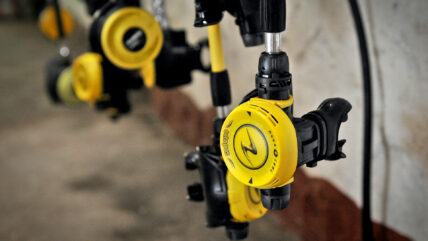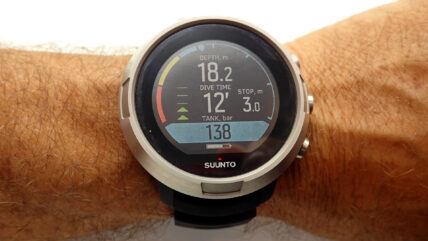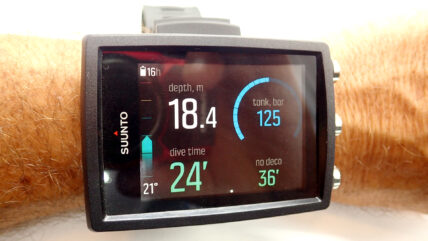Basic Scuba Diving Equipment
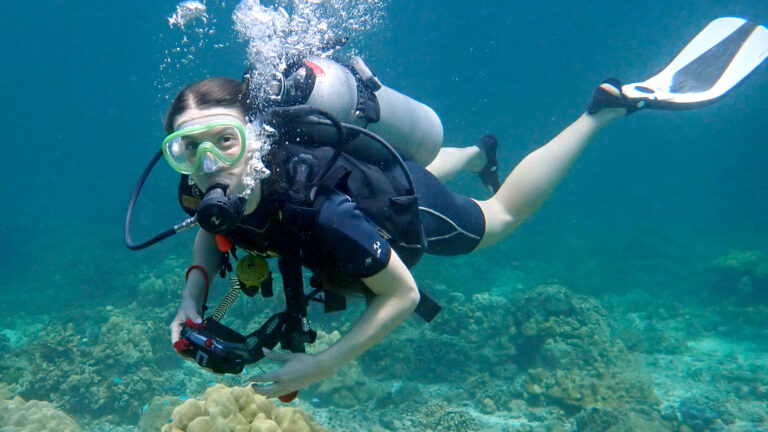
Although there are different styles of scuba diving, basic scuba diving equipment consists of: a mask and snorkel, diving fins (sometimes with boots), a wetsuit (or other exposure suit), a buoyancy control device (a jacket style BCD for example), some type of weighting system, a scuba regulator (with a pressure gauge and alternate air source), a dive computer & compass (highly recommended – rather than just dive planning tables/software, a depth gauge and a simple timing device), and a scuba tank / cylinder. There are also very many accessories that can greatly enhance your diving but having your own set of basic scuba gear will ultimately lead to a much better diving experience.
In case you are new to scuba diving, we’ll first explain a little about each item of basic scuba gear, then why you’ll benefit from buying your own scuba gear, what to buy first and how to choose what’s best for you, where to buy scuba gear, and finally suggestions on what to do when diving with new scuba gear for the first time.
Scuba Masks & Snorkels
Masks
Without a scuba mask we can’t see very well underwater. Our eyes are used to focusing in air and we need the air-space, created by the mask, to see clearly. The light we see, that is reflecting off of objects, bends as it passes through the water to air, and it’s that ‘refraction’ that allows us to focus correctly.
As we dive down, the pressure increases with depth and therefore we must use masks that cover both our nose and our eyes so that we are able to equalize the air space in the mask, by blowing out through our nose. For example, if we tried to use goggles that only covered our eyes, we wouldn’t be able to equalize the air space in the googles and we’d hurt our eyes: the pressure would try to ‘squeeze’ our eyes into the googles… ouch!
Full Face Masks
Most masks cover just the eyes and nose, but there is another variety called a ‘full face mask’ that covers the mouth as well. With full face masks the scuba regulator is fitted directly to the mask, enabling you to breathe from your mouth and your nose – and you can even talk to your buddy if a communication system is attached!
There’s a slightly different technique for equalizing the air space in full face masks and a normal backup mask plus a standard regulator 2nd stage are also required. Actually, although there can be benefits to using a full face mask, they aren’t quite as easy to use as it sounds and so there are special diving courses (like the PADI Full Face Mask Specialty) that teach you how to use them safely.
Snorkels
Although snorkels aren’t 100% necessary, it’s certainly a good idea to have one (even if it’s one that rolls up into your BCD pocket). Using a snorkel allows you to breathe more easily at the surface whilst saving the air from your scuba tank.
Snorkels are especially useful when there are long surface swims to / from a dive site and your entry / exit point, or perhaps when waiting at the surface for an extended time and also if the waves are a bit ‘choppy’. Plus, if for some reason you aren’t diving, you can always go snorkeling!
Scuba Diving Fins (And Boots)
Generally speaking, we shouldn’t be using our arms to move along when scuba diving. Our legs are much stronger and, when we are wearing fins, are much more efficient at pushing our bodies and scuba tank through the water… did someone say ‘flippers’?. Also, if you do use your arms to try and swim, you are likely to hit your dive buddy in the face… and they won’t want to be your buddy anymore!
Open Heel Fins
In warm water environments or when travelling light, full foot fins are very popular. These types of fin are similar to snorkeling fins (though usually a little firmer / larger) and usually have a foot-pocket that your foot fits into – although some newer designs have an adjustable or spring strap with a foot-pocket that’s not fully enclosed.
Full Foot Fins
In colder water environments or when diving more often (perhaps from beaches), fins that require diving boots are preferred. Obviously, the boots insulate your feet and provide greater foot protection. They also allow for the use of heavier / larger / firmer fins which are especially useful for diving in strong currents or for technical scuba diving, where you may sometimes need to push / fin a little harder that usual.
Fins that require boots have bigger open-heel foot pockets and either adjustable or spring straps to hold the fin in place – although often it’s the ‘suction’ created by the boot in the fin’s foot pocket that does most of the work to hold the fin firmly.
Fins For Travelling
If you want an ‘in between’ alternative to boots and fins, then neoprene diving socks in combination with slightly larger full foot fins can be a good option, especially for travelling. Many of the latest fins are made from strong but flexible lightweight materials. They may cost a little more than conventional ‘rubber’ fins but may save weight (and potential baggage costs) without comfort or reducing performance.
Wetsuits & Exposure Suits
Generally. there are 3 types of ‘suits’ that you’ll wear for scuba diving: dry suits (for cold water environments), wetsuits (for moderate to warm water environments), and skin suits (for warm water environments).
Dry Suits
Dry suits are one-piece suits that cover your whole body, and include boots that are permanently attached. Dry suits must fit extremely well, so are often custom fitted, and they have strong seals around the neck and wrists, so as not to let any water in. You wear some sort of undergarment to help keep you warm and often wear separate gloves and hoods, for further protection from cold water.
Dry suits provide an insulating layer of air (with extra insulation from undergarments) which needs equalizing (just like the air space in a mask), otherwise you can get a ‘squeeze’ (pressure injury) on some part of your body. There are valves on dry suits which allow you to inflate / deflate the suit to avoid squeezes and control your buoyancy also. Just like you learn to control buoyancy using a BCD during a PADI Open Water Course, you can also learn how to use a dry suit and control buoyancy through taking another course: the PADI Dry Suit Specialty… otherwise you may be diving upside down, with all the air in the dry suit around your feet and ankles!
Wetsuits
As the name implies, a wetsuit works by letting water in-between the suit ad your body but should fit suitably well so as to restrict the water flow. Heat from your body warms up that layer of water, which works in combination with the layer of neoprene (the rubber-like material that a wetsuit is usually made from) to insulate you from the surrounding water and keep you warm.
Wetsuits can be one-piece, having either long or short arms and / or legs (a short wetsuits is often referred to as a ‘shorty’), or can consist of a separate sleeveless, short-sleeve or long-sleeve jacket worn with shorts or long trousers – some wetsuits / jackets have hoods attached too. They may have zips, buckles and / or Velcro straps to help with fitting and can be of various thickness neoprene, for extra comfort or warmth. Some come ‘fleece’ lined and some have extra seals on the wrists and ankles to make them ‘semi-dry’ wetsuits.
Water absorbs heat from your body around 20 times quicker than in air, so even if diving in water that’s close to body temperature, you’ll likely still get cold after a while. Wetsuits also provide padding that can make wearing BCDs and harnesses more comfortable. Wetsuits come in many sizes and different brands fit slightly differently, so it’s best to try them on and find one that’s good for you – bearing in mind, some are unisex and some only for women / men.
Skin Suits
Skin suits do very little to keep you warm and are mostly for sun protection. You can buy ‘proper’ full body skin suits (often made of Lycra or a similarly elastic fabric), or thin diving shorts and rash-guard tops, or just use ordinary sport-tops and beach shorts.
Obviously, skin suits are only for use in really warm water environments or worn underneath in combination with a wetsuit.
Scuba Tanks (Cylinders)
Scuba cylinders come in various sizes and are made from either steel or aluminium. They usually hold a maximum gas pressure of 200 to 300 bar (1 bar = 1 atmospheric pressure, approximately) depending on their type and also the style of valve used (yoke or DIN).
There are regional differences as to which is the most common type / size of scuba cylinder and type of valve used. For example, In the warmer water of Thailand (where we are based) the most common type are aluminium cylinders of around 11 litres (internal volume), with mostly yoke valves ut some DIN valves too, that can be converted to yoke (by inserting a small adapter).
Steel Scuba Cylinders
Cylinders made from steel usually have thinner walls, tend to be more negatively buoyant and are often used in colder waters, where the extra negative buoyancy assists with needing fewer weights to compensate for using dry suits and thick wetsuits (which are usually very buoyant). Steel cylinders are used when 300 bar is required, and they all tend to be painted to help prevent rusting.
Aluminium Scuba Cylinders
Scuba cylinders made from aluminium are usually negatively buoyant when full but become positively buoyant between 100 – 140 bar, depending on their size and variations in manufacturing, and their maximum working pressure is usually just a little over 200 bar. They can be painted but most often are left in their original grey / silver colour, perhaps because they don’t look good when the paint chips off… and that isn’t good for the environment!
Yoke Yalves
Yoke valves allow for the attachment of yoke regulators (a yoke 1st stage or a DIN 1st stage plus an adapter) to the scuba tank. The yoke 1st stage (of the regulator) clamps onto a yoke valve, first by centering the inlet port of the 1st stage over the o-ring of the valve (where the gas is going to come out), and then by tightening up the fitting on the rear-side of the valve… so the 1st stage clamps onto the valve: the join being sealed by the o-ring.
DIN Yalves
DIN valves (Deutsche Industrie Norm) have a threaded opening in the valve that the regulator’s DIN 1st stage screws directly into. The o-ring is on the 1st stage itself, rather than on the valve (as with yoke types), and forms a much more secure connection than the yoke type. For this reason, DIN is the required valve / regulator type for technical diving and is absolutely necessary for when 300 bar is needed.
BCDs (Buoyancy Control Devices)
As in the title, BCD stands for Buoyancy Control Device: by adding or removing air (inflating or deflating), they allow you to control how much you float (positive buoyancy – to rest on the surface) or how much you sink (negative buoyancy – to rest on the bottom), though the idea is to find the right balance to remain neutrally buoyant (seemingly weightless midwater) to make it easy to dive / swim in any direction.
BCDs come in many varieties, the types most used being: a BCD jacket (for a single tank on your back); a harness, backplate and wing (for either a single or double tanks on your back); and a harness with a wing (for sidemount diving – 1, or more tanks). When we refer to a ‘wing’, we mean an air cell / bladder that can be of various shapes and sizes, depending on the BCD configuration.
Jacket BCDs
Jacket BCDs are by far the most common type of buoyancy control device for scuba. They come in various sizes to fit different divers, are easy to put on and adjust, often have large pockets and sometimes d-rings for stowing and clip-on accessories, and may also have quick-release weight pockets (for use instead of or in combination with a weight-belt).
When learning to dive, you’ll most likely use a jacket style BCD, especially in temperate or warm water environments – and likely your scuba instructor will be wearing one also. With the various belts, buckles and fasteners that are included in jacket BCD designs, they make (donning & adjusting them and learning & performing equipment removal / replacement exercises easier.
Jacket BCDs are usually one-piece systems, where perhaps only a few parts can be removed & replaced, such as the cummerbund (wide material / Velcro straps that wrap around your waist, for comfort) and the inflator hose / unit. The inflator unit connects (via a low pressure inflator hose – LPI) to your regulator, which allows you to add air from your scuba cylinder or orally (you inflate it by blowing into it). You can also deflate the BCD using a second button on the inflator. There are also over-pressure valves (dump valves) that stop the BCD from bursting if over-inflated, and you can use these same valves to more quickly deflate (dump air from) the BCD.
A few disadvantages of jacket BCDs are: they aren’t adaptable / customizable, they can’t be resized, and if they get damaged / punctured, an external repair to the bladder doesn’t look good and may not last / be dependable: so you may have to buy a whole new BCD.
Harness, Backplate & Wing BCDs
Harness, backplate & wing BCDs are steadily becoming more popular. As suggested, they are modular (component based), making them more adjustable / customizable for personal preference and for changes due to configuration requirements (perhaps to fit a bigger wing for using double cylinders) or environmental changes (perhaps to extend harness webbing or add extra weight pockets if changing from using a thin wetsuit to using a bulky dry suit).
Although backplate and wing BCDs may seem a little more expensive, in the long run they can save money because you don’t have to replace everything if you want to change something or have to make repairs. In fact, due to most wings of this type having internal air cells (bladders), much like a bicycles inner-tube, repairs are hidden and tend to be more permanent and secure.
Many divers use backplate and wing BCDs for single cylinder use, but because extra d-rings / mounting attachments can be added easily and are far more secure on the harness’s tough webbing, these types of BCDs are a requirement for back-mount technical diving where deco cylinders and other equipment must be attached. Harnesses for technical diving tend to veer away from having adjustable shoulder buckles (as they are seen as a potential failure point) which can make them a little more awkward to get on / take off. However, in recent years, with buckles being made from stronger materials more tech divers are adding a buckle to one or both shoulders.
More recreational & travel orientated backplate and wing BCDs come with only soft backplates or extra padding on light aluminium backplates. They likely also have more adjustable buckles (similar to jacket style BCDs) and perhaps chin-straps for ease of donning and adjustment.
Apart from a little additional work to set them up, or maybe a little extra initial cost, there’s nt much disadvantage to backplate and wing BCDs, unless you just don’t like the style of them. And they can take a bit of getting used to if you’ve learned in jacket BCDs: Because the wing is entirely on the back, they can throw you forward a little at the surface, especially if fully inflated, until you find your balance using them.
Sidemount Harness & Wing BCDs
With a sidemount wing and harness there’s usually no backplate (although you can get some hybrid multipurpose BCDs) and the wing is usually a little smaller and more like an air-filled pillow; backplate BCDs usually have donut or horseshoe shaped wings. As the name suggests, this type of configuration allows for the mounting of one or more scuba cylinders along the side of your body.
Having no backplate means less weight / bulk and makes a sidemount wing & harness a great option for travelling. Sidemount diving is also very streamlined, often saving energy and gas consumption, and has other advantages too. But there are some disadvantages to a sidemount setup: it’s not quite as easy as just jumping into a jacket BCD with one cylinder on your back, and so there are dedicated courses for this style of diving, like the PADI Sidemount and the PADI Tec Sidemount courses.
Weight Belts / Weight Systems
Often overlooked (even just before a dive!), weight belts and other weighting systems are an essential part of scuba diving, and are actually part of your buoyancy control system: without them you may not be able to sink or stay down as a dive progresses. Most commonly used are simple weight belts with quick release buckles, then there are quick release weight pockets (often an integral part of jacket BCDs but can be added to backplate / sidemount harnesses) and then there are dedicated weight harnesses that are worn under the BCD. There are also options add weights to / around scuba tanks, via weight pockets or attachments to tank band webbing, but we’ll concentrate on explaining the 3 main weighting systems.
Weight Belts
Using weight belts, to hold the weights necessary to dive with, is the simplest and most cost-effective weighting system: they are usually just a piece of 2 inch webbing with a plastic or metal buckle (recommended) that allows for a quick release, in the event that you need to go to the surface more quickly / easily. Weight belts aren’t as comfortable as other systems and one other disadvantage is that they can be accidentally release if not fitted properly or are too long / have a long loose end.
Weight Pockets
As previously mentioned, these are often an integral part of more complete jacket style BCDs or can be added to the harnesses of backplate / sidemount BCDs. Although an extra expense, quick release weight pockets are usually a lot more comfortable to dive with – partly because it’s one less belt around your body! The quick release will usually be via a clip, Velcro fastener, or a combination of both. Although fairly easy to use, it’s always a good idea to check that they are installed correctly and not worn / damaged: weights and pockets are often lost if not checked.
Weight Harnesses
Weight harnesses are like a set of study braces for your trousers: they are worn underneath your BCD or other harness and allow for the carrying of additional weights, such as when diving in a dry suit or when wearing a particularly thick and buoyant wetsuit. They can make it more comfortable for carrying lots of weight but usually there’s no way to quick release this weight – though in technical diving (when you might need more weight) being able to stay down is the priority: you can’t just go directly to the surface in the event of an emergency.
Scuba Regulators
Scuba regulators allow divers to easily breathe underwater by adjusting the pressure of the gas, coming from the scuba cylinder (most often just air), to match the surrounding water pressure. The typical regulator system is made of of 5 main parts: a 1st stage, a main 2nd stage, an alternate second stage (often called an ‘octopus’), a submersible pressure gauge (SPG), and a low pressure inflator hose (LPI). There may be some other attachments to a regulator’s 1st stage, such as a pressure transmitter, a hose for a dry suit, or perhaps the alternate second stage is part of the BCD’s low pressure assembly instead. Sometimes, they also have a depth gauge included as part of a console that also holds the SPG.
A scuba regulator also allows you to inflate you BCD (via the low pressure inflator) and also add air to a dry suit if one is being used.
Regulator First Stage
As mentioned in the section for scuba cylinders, there are 2 types of scuba regulator 1st stages: yoke and DIN (usually, divers just refer to having yoke or DIN regulators). There are also balanced and unbalanced first stages: balanced being easier to breathe from at depth (though most modern / quality regulators have balanced 1st stages). There are regulators which have environmental seals and heat sinks to help stop them from freezing-up in very cold water environments, and there are other differences in regulator 1st stage designs, such as diaphragm or piston type (but we won’t go into the internal workings of these here).
To recap a little, a yoke 1st stage clamps onto the valve of the scuba cylinder, whereas a DIN 1 stage screws directly into the valve, is more secure and can handle higher pressures. Whatever type of regulator 1st stage you have, it’s designed to change the high gas pressure coming from the scuba cylinder to an intermediate pressure of around 10 bar, which is then distributed to the 2nd stages and the LPI hose(s): the SPG receives unadjusted high pressure.
Regulator Second Stage
A regulators main 2nd stage (usually black or dark in colour) is the part that the diver breathes from. It receives gas from the 1st stage at about 10 bar pressure and changes it to the same pressure as the surrounding water: Very simply, when you breathe in, a diaphragm is drawn against a lever to open a port and let gas (usually air) into an expansion chamber, where the gas expands as much as the water pressure will allow. When you breathe out, another diaphragm opens the other way and lets your breath out.
Alternate Second Stage
A regulators alternate 2nd stage (often called an ‘octopus’) is usually brightly marked and for a diving buddy to share air from if out of air themselves. It works exactly the same way as the main 2nd stage, just needing to be clearly marked and easily accessible for your diving buddy. Often, the alternate 2nd stage is on a longer host.
On some scuba systems, there is an alternative 2nd stage integrated into the BCDs low pressure inflator unit. In this case. if a buddy needs to share air from this system, the main diver would switch to the alternative 2nd stage on the LPI unit and provide the out-of-air diver with the main 2nd stage instead.
Low Pressure Inflator Hose (LPI Hose)
A low pressure inflator hose supplies air to your BCD (and dry suit if a 2nd hose is attached) at the intermediate pressure of about 10 bar and connects to the inflator unit of your BCD via a Schrader valve connector (it has a quick release mechanism – just in case there’s a malfunction or leak).
Some divers attach a 2nd LPI hose, or temporarily disconnect the one from their BCD, to use for inflating a DSMB (delayed surface marker buoy) if it has an inflation nozzle suitable for a Schrader valve.
Submersible Pressure Gauge (SPG)
A submersible pressure gauge shows the pressure of the gas in the scuba cylinder. Nowadays, they are fairly accurate, very reliable and a necessary part of your regulator even if using a pressure transmitter (attached to the 1st stage).
They show pressure either in BAR or PSI (or sometimes both), the later being more popular in the Americas.
Depth Gauge (on regulator console)
Although not a necessary part of a regulator, analogue depth gauges are most likely found on a console which also holds the SPG., so we thought it most appropriate to mention them here. Although you can get wrist mounted depth gauges, most divers usually opt for a dive computer (which will have a depth sensor), though they’ll often have the analogue console mounted depth gauge as a backup.
Dive Computers
When diving, some sort of depth gauge and timing device are mandatory equipment so as to dive safely within your dive plan. However, because dive computers are now so affordable and have many more functions than a basic timing device and depth gauge, most divers buy a dive computer (often as their first item of scuba equipment), and so we thought it best to include them in with all the other basic gear required for diving.
There are many types and styles of dive computer available, each with various options and functions. The main types of dive computer are: air only, nitrox capable and multi-gas / decompression diving capable (We’ll consider the first 2 types recreational only). Within those main types, there are other variations also, such as multi-gas decompression computers that can cater for trimix (using helium also). Some computers can be mounted on a console with your SPG, though most computers are wrist mounted (preferred by most divers).
As most divers go for wrist mounted dive computers, apart from the capability of different types, perhaps the next type / style that influences a divers choice is whether it’s a watch style (to be worn most of the time) or a more bulky style computer (that a diver would only wear whist diving).
Air only dive computers have almost all been replaced by recreational nitrox capable types, so we’ll focus on the later along with multi-gas decompression types.
Note: A dive requiring decompression stops is NOT the only definition of a technical dive. For example, diving in an overhead environment is a ‘technical’ dive but that doesn’t necessarily mean going beyond no-decompression dive limits and requiring decompression stops. So, ‘recreational’ dive computers can be used in some forms of technical diving – just not those requiring decompression stops – however it may be better to have a multi-gas decompression capable dive computer, in the event that delays on a normally ‘non-deco’ technical dive force a diver into needing decompression stops.
Important: Although your dive computer may be capable of many functions, including multi-gas decompression diving, you should always dive within your personal training, experience and certification limits.
Recreational Dive Computers
Although dive computers for recreational diving may be used in some forms of technical diving, they are designed to function within normal ‘no-decompression’ diving limits. In the event that you dive with them beyond those limits, they will usually display instructions to perform an emergency decompression stop (and then likely a safety stop also) but then, after that dive, will most likely lock-out / go into an error mode for a certain period of time (often 48 hours) because they aren’t designed for repetitive decompression diving.
Most modern dive computers can be used for multiple modes: air, nitrox, gauge and free-dive, for example. They may have dive planning features, have glow in the dark displays or a backlight, and can also include other features such as USB and Bluetooth connection options, for downloading dive details to a digital log book, or even letting you know you have calls / messages of your mobile phone.
Some dive computers have simply monochrome displays, while others have customizable brightly coloured displays. The more advanced recreational computers also allow for the use of transmitters (connected to your regulator’s 1st stage) to send tank pressure to the computer… they may even estimate how long your gas will last at your current depth! And they may also have settings to adapt for diving at altitude or with a personal factor applied.
Decompression Dive Computers
Just as with dive computers for recreational diving, multi-gas decompression computers also come in both watch styles and the more bulky ‘worn for diving only’ styles. They may have all the same operating features as mentioned for recreational types but will include additional software for being able to select / change settings for different gases used during a dive (air, nitrox, oxygen and perhaps helium).
The additional software in these computers will also allow for repetitive decompression diving, showing depths and times for decompression stops during the ascent phase of a dive and likely also have extensive planning features for deco dives, including gas requirements. The software may allow you to enter personal information and preferences, such as your working and decompression gas consumption rates, your preferred decompression algorithm with various settings for it… Some even allow for attachments to use the computer to analyze the gases to be used for the dive!
Multi-gas decompression dive computers are more expensive than most recreational types, but the multitude of features that they come with means you’ll be able to use them in the future, as you progress through many different forms of diving.
Other Dive Gear & Accessories
The diving equipment listed and described above by no means covers all the dive gear you’ll ever need or want, it’s simply the basic gear that you’d need for ‘open circuit’ scuba diving… If you are looking at semi-closed or closed circuit rebreathers, well that’s a whole additional set of diving equipment and training!
As for scuba diving accessories, there’s an almost never ending list of items that we could write about! Sure, there are some accessories that you are going to want / need, like a DSMB (delayed surface marker buoy) for example. But you don’t want to end up looking like a Christmas tree and being un-streamlined on your dives. So be sensible and take what you really need to enjoy your diving and dive safely! We’ll write about scuba diving accessories in another blog 🙂
